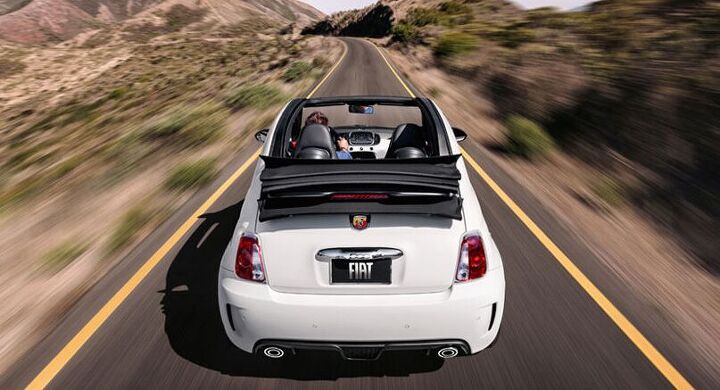The Struggle is Real: Fiat is Aggressively Reducing Prices for 2017

Fiat’s pain is your gain, assuming you are in the market for something small and quirky.
As expected, the company’s revamped pricing structure will drop the sticker on many of next year’s models. That includes a $5,205 reduction on the company’s squirrely little scorpion, the 500 Abarth, if outfitted correctly.
According to documents obtained by Automotive News, Fiat’s going to be aggressively cutting prices in 2017. The pricing adjustments were eluded to in March after a special North American Fiat dealers summit convened to save the faltering brand. By September, we began learning exactly what that could mean for the brand with consistently declining U.S. sales.
The intercepted document sent out to Fiat dealers indicates an markdown of the base 500 from $16,995 to $14,995 and a $5,205 drop in the 500 Abarth Cabrio. It also outlines that the company will have fewer trim levels for its lineup, seemingly done to avoid continued pricing overlap. Reducing the open-topped Abarth to a more modest $21,490 provides important breathing room between it and Fiat’s incoming 124 Spider.
500 trims have been cut from six to three, with the convertible being a $1,495 option on all of them. The 500L and 500X have been similarly deflated, with the 500X priced slightly higher overall. FCA’s head of passenger car brands, Tim Kuniskis, told Automotive News that the 500L and 500X had been “tripping over each other” in both pricing and content. The 500X essentially came into existence only to steal potential sales from the 500L. While still similar in cost and offerings, the limited number of trims helps to better differentiate the vehicles.
Fiat’s reintroduction as a U.S. brand in 2011 has been difficult. North American sales peaked in 2014 and began to slide as the brand introduced more models to its lineup. Compared to last year, Fiat’s U.S. sales have declined every month in 2016.
[Image: Fiat Chrysler Automobiles]

A staunch consumer advocate tracking industry trends and regulation. Before joining TTAC, Matt spent a decade working for marketing and research firms based in NYC. Clients included several of the world’s largest automakers, global tire brands, and aftermarket part suppliers. Dissatisfied with the corporate world and resentful of having to wear suits everyday, he pivoted to writing about cars. Since then, that man has become an ardent supporter of the right-to-repair movement, been interviewed on the auto industry by national radio broadcasts, driven more rental cars than anyone ever should, participated in amateur rallying events, and received the requisite minimum training as sanctioned by the SCCA. Handy with a wrench, Matt grew up surrounded by Detroit auto workers and managed to get a pizza delivery job before he was legally eligible. He later found himself driving box trucks through Manhattan, guaranteeing future sympathy for actual truckers. He continues to conduct research pertaining to the automotive sector as an independent contractor and has since moved back to his native Michigan, closer to where the cars are born. A contrarian, Matt claims to prefer understeer — stating that front and all-wheel drive vehicles cater best to his driving style.
More by Matt Posky
Latest Car Reviews
Read moreLatest Product Reviews
Read moreRecent Comments
- SCE to AUX Range only matters if you need more of it - just like towing capacity in trucks.I have a short-range EV and still manage to put 1000 miles/month on it, because the car is perfectly suited to my use case.There is no such thing as one-size-fits all with vehicles.
- Doug brockman There will be many many people living in apartments without dedicated charging facilities in future who will need personal vehicles to get to work and school and for whom mass transit will be an annoying inconvenience
- Jeff Self driving cars are not ready for prime time.
- Lichtronamo Watch as the non-us based automakers shift more production to Mexico in the future.
- 28-Cars-Later " Electrek recently dug around in Tesla’s online parts catalog and found that the windshield costs a whopping $1,900 to replace.To be fair, that’s around what a Mercedes S-Class or Rivian windshield costs, but the Tesla’s glass is unique because of its shape. It’s also worth noting that most insurance plans have glass replacement options that can make the repair a low- or zero-cost issue. "Now I understand why my insurance is so high despite no claims for years and about 7,500 annual miles between three cars.


































Comments
Join the conversation
Vulpine, this is of course all in jest. But seriously, data speaks: http://www.zeroto60times.com/vehicle-make/dodge-0-60-mph-times/ look at the GLHS Shelby - in low 6 s range, 30 years ago. FWD and all. Neon SRT4 is faster... As for the total cost of ownership... depreciation of the car has more to do with it than anything else. intra segment, cars have similar fuel economy. http://www.edmunds.com/tco.html?mktcat=tco&kw=total+cost+of+ownership&mktid=ga56677243&gclid=CjwKEAiAmdXBBRD0hZCVkYHTl20SJACWsZj9GIj21gs7jQMKA1rpLvADoX4hUIvUVanhU602oy8duxoCXQ3w_wcB Enjoy your car, and please keep an open mind when you will be looking for another car.
At 22000 for an Abarth cabrio, i am IN.